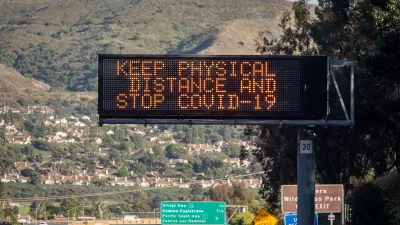Though more and more cities realize that walkability and livable streets are essential to their prosperity, their approach to pedestrian safety is often lacking. The slow pace of policy change isn't fast enough for the victims of "accidents".
Cities like New York, San Francisco and, increasingly, Los Angeles are known for their lively street life. But as recent news stories indicate, they're becoming equally well known for their abysmal record of protecting pedestrians from vehicular collisions, and punishing drivers who kill and injure those on two feet.
Sarah Goodyear has written with eloquent outrage about the lack of consequences for drivers who plough into pedestrians on New York's streets and sidewalks, and elsewhere. The latest incident to catch her ire involves the striking of five children by an out-of-control driver on a sidewalk in the Maspeth neighborhood of Queens last week.
"You might think, if you’re not from New York, that the guy who was behind the wheel would automatically be in big trouble for causing this kind of mayhem," she says. "But as I've written before, it isn’t like that here."
The New York Police Department has gone to great lengths to publicize reforms to how it handles traffic crashes. As Kate Hinds points out in her article on the Maspeth incident for Transportation Nation, "[e]arlier this year the NYPD instituted reforms to its then-named Accident Investigation Squad, whose 19 officers covered the entire city and only investigated traffic crashes resulting in death. Now, the newly renamed Collision Investigation Squad is taking a harder look at more crashes." However, as another recent article by Goodyear indicates, the "considerable expansion of police resources toward traffic safety" doesn't seem to have radiated throughout the department.
Planetizen has just published an article that looks at one promising tool that's being deployed in New York City: Pedestrian/Traffic Managers (PTM's). Though they've been shown to increase pedestrian safety in select areas of the city, the PTM is a tool that has limited application. You can't deploy a PTM at every street corner. And even if you could, that wouldn't prevent the inevitable "out-of-control" driver.
In Los Angeles, where almost half of all crashes are hit-and-runs, a new state law will increase the statute of limitations for such incidents from three years to six. "It is a small step forward, not just legally, but also in terms of signaling that the community at large recognizes that the hit-and-run epidemic is real," observes Goodyear. However, "[i]nvestigations by the LAPD into hit-and-run crimes are all too often lackluster, as [Simone] Wilson’s reporting in LA Weekly showed. And if the police aren’t motivated to search out those who drive away from the scene of a crash, it doesn’t matter if the statute of limitations is 3 years, or 6, or 26.
Though the official approach to pedestrian safety and traffic collisions appears to be improving, tell that to the Queens eight grader with the broken pelvis or the British tourist whose leg was severed in Midtown Manhattan.
FULL STORY: Even After 5 Kids Were Mowed Down on a New York Sidewalk, Nothing Much Changes

Alabama: Trump Terminates Settlements for Black Communities Harmed By Raw Sewage
Trump deemed the landmark civil rights agreement “illegal DEI and environmental justice policy.”

Planetizen Federal Action Tracker
A weekly monitor of how Trump’s orders and actions are impacting planners and planning in America.

The 120 Year Old Tiny Home Villages That Sheltered San Francisco’s Earthquake Refugees
More than a century ago, San Francisco mobilized to house thousands of residents displaced by the 1906 earthquake. Could their strategy offer a model for the present?

In Both Crashes and Crime, Public Transportation is Far Safer than Driving
Contrary to popular assumptions, public transportation has far lower crash and crime rates than automobile travel. For safer communities, improve and encourage transit travel.

Report: Zoning Reforms Should Complement Nashville’s Ambitious Transit Plan
Without reform, restrictive zoning codes will limit the impact of the city’s planned transit expansion and could exclude some of the residents who depend on transit the most.

Judge Orders Release of Frozen IRA, IIJA Funding
The decision is a victory for environmental groups who charged that freezing funds for critical infrastructure and disaster response programs caused “real and irreparable harm” to communities.
Urban Design for Planners 1: Software Tools
This six-course series explores essential urban design concepts using open source software and equips planners with the tools they need to participate fully in the urban design process.
Planning for Universal Design
Learn the tools for implementing Universal Design in planning regulations.
Clanton & Associates, Inc.
Jessamine County Fiscal Court
Institute for Housing and Urban Development Studies (IHS)
City of Grandview
Harvard GSD Executive Education
Toledo-Lucas County Plan Commissions
Salt Lake City
NYU Wagner Graduate School of Public Service




























